
AI and Data Quality: Top Trends and Takeaways from IIeX 2025
May 5, 2025
Use It or Lose It: Who’s Actually Using Generative AI?
May 13, 2025Since the launch of ChatGPT, for some of us, it seems like generative AI is everywhere, but with the general public, it is a bit of a different story. We explored how familiar people are with various generative AI platforms in our recent wave of research-on-research, using a simplified five-point scale focused on top-two box responses—those who are either “very” or “extremely” familiar with each platform.
Let’s dive into what we uncovered:
Overall
Overall, the generative AI platform with the highest familiarity was ChatGPT, with 33% of respondents. Gemini follows at 26%, with Copilot not far behind at 22%. Claude and Grok are behind at 13% each, reflecting more limited exposure.

Wave-Over-Wave
A wave-over-wave comparison over the last four waves of our research-on-research shows clear upward trends in awareness. From Wave 1 to Wave 4, ChatGPT saw steady growth in familiarity, rising from 23% to 33%. Gemini nearly doubled over the same period, moving from 12% to 26%, and Copilot followed a similar path, increasing from 12% to 22%. Meanwhile, Grok and Claude each gained traction, climbing from single-digit familiarity to 13% by Wave 4.
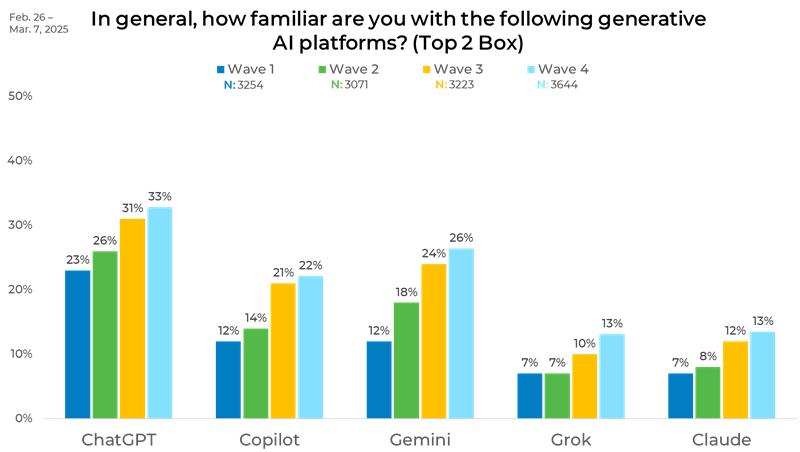
Gender
Gender differences reveal notable disparities. Men report significantly higher familiarity across all platforms. For instance, 42% of male respondents are familiar with ChatGPT compared to 25% of females. This pattern is consistent with Gemini (34% vs. 20%), Copilot (30% vs. 15%), and extends to Claude and Grok.
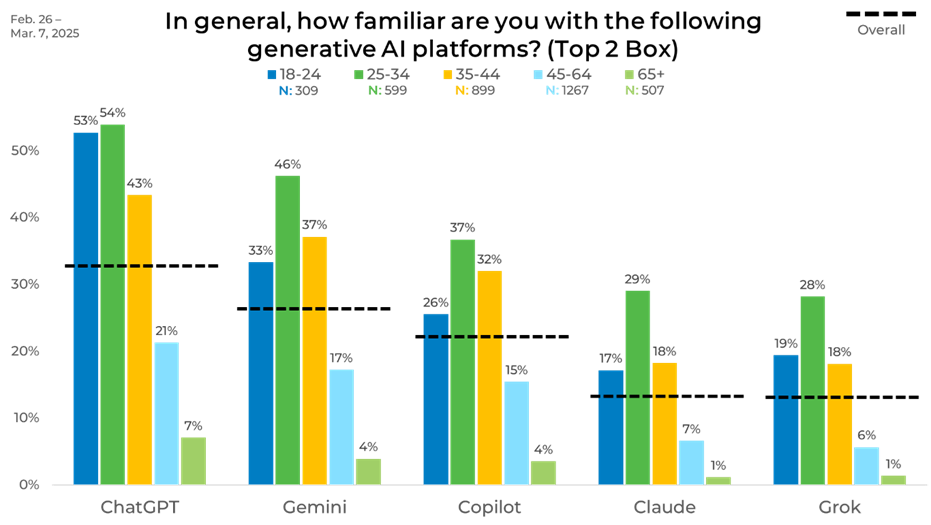
Age
Like with most technology, Age plays a significant role in familiarity levels. Overall, familiarity declines as age increases. Among those aged 18-24 and 25-34, 53% and 54% are highly familiar with ChatGPT, while awareness among the 35-44 group drops to 43%. Younger respondents also show strong familiarity with Gemini (33% and 46%) and Copilot (26% and 37%). In contrast, only 21% of those aged 45-64 and just 7% of those 65 and older are familiar with ChatGPT. The drop is also consistent across other platforms—Gemini recognition declines to 17% and 4%, and Copilot to 15% and 4% in these older groups. The 18-34 age segment consistently leads across all platforms, marking a sharp divide in generational engagement with AI technology.
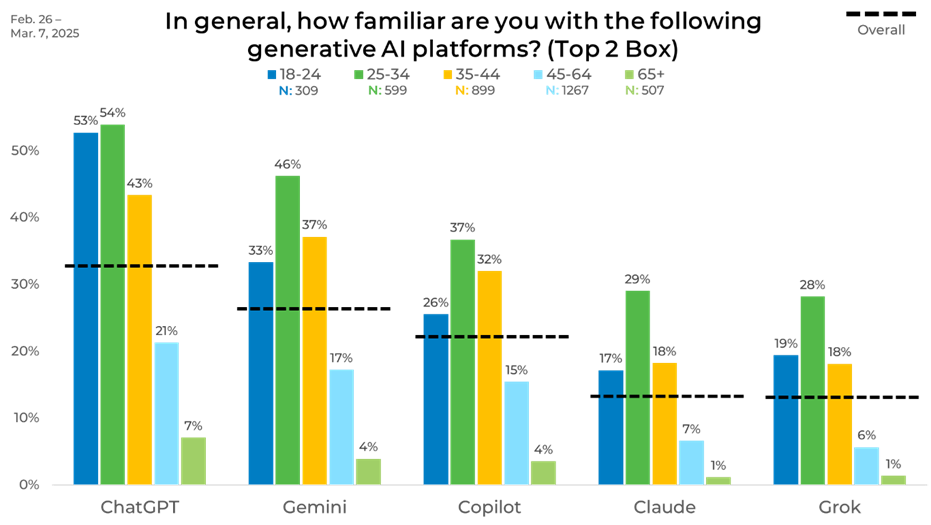
Income
As we saw that with age, where familiarity declined with age, we see an inverse trend regarding income – the higher the income, the higher the familiarity. For ChatGPT, familiarity rises steadily from 22% among those earning under $20,000 to 51% among those making over $100,000. Gemini follows a similar trend, increasing from 21% in the lowest bracket to 38% in the highest. Copilot jumps from 15% to 36% across the same income range. Claude and Grok, though less recognized overall, still reflect this pattern—awareness of Claude climbs from 10% to 24%, and Grok from 11% to 22%. These consistent gains across income tiers suggest financial resources may impact exposure to and engagement with AI platforms.
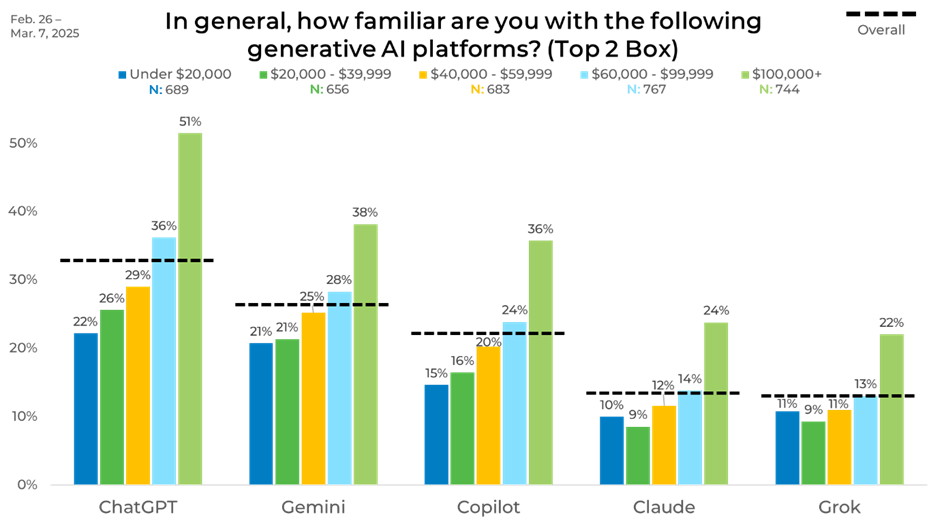
Ethnicity
Familiarity with generative AI platforms differs notably across ethnic groups. Hispanic/Latino and African American respondents report the highest awareness of ChatGPT at 46% and 43%, respectively, compared to 29% among Caucasian respondents. These groups also show strong recognition of Gemini (38% for Hispanic/Latino, 37% for African American) and Copilot (31% each), exceeding the rates seen among Caucasians (23% and 19%). Asian or South Asian respondents report 40% familiarity with ChatGPT and moderate levels with Gemini (28%) and Copilot (24%), while those identifying as Other align more closely with the overall average. These differences highlight a varied landscape of AI platform engagement across ethnic lines.
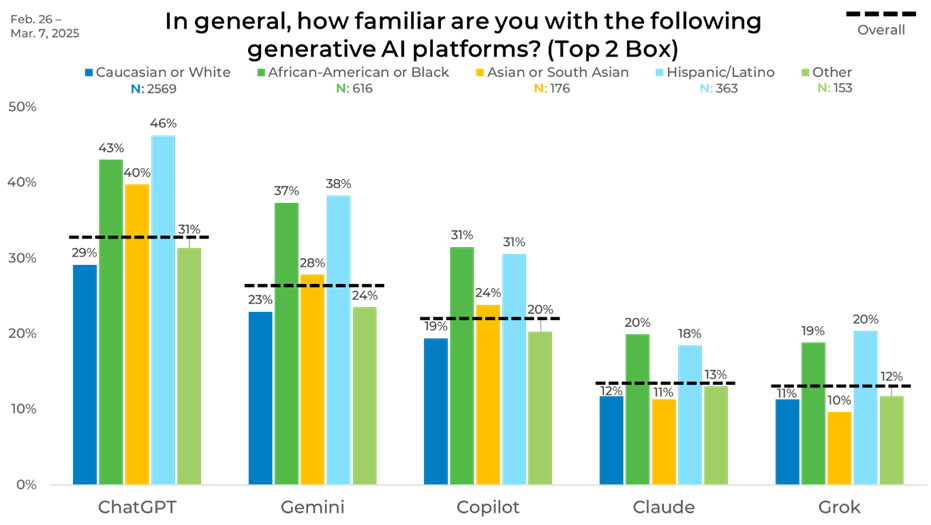
Panel
Panel differences further highlight how sample sources can influence results. ChatGPT awareness ranges widely from 20% with Panel A to 62% with Panel P. This pattern holds across all platforms, with Panel P consistently reporting the highest levels of familiarity. These differences reinforce the value of blending panels for a more complete view, reducing the risk of skewed insights from any single sample source.
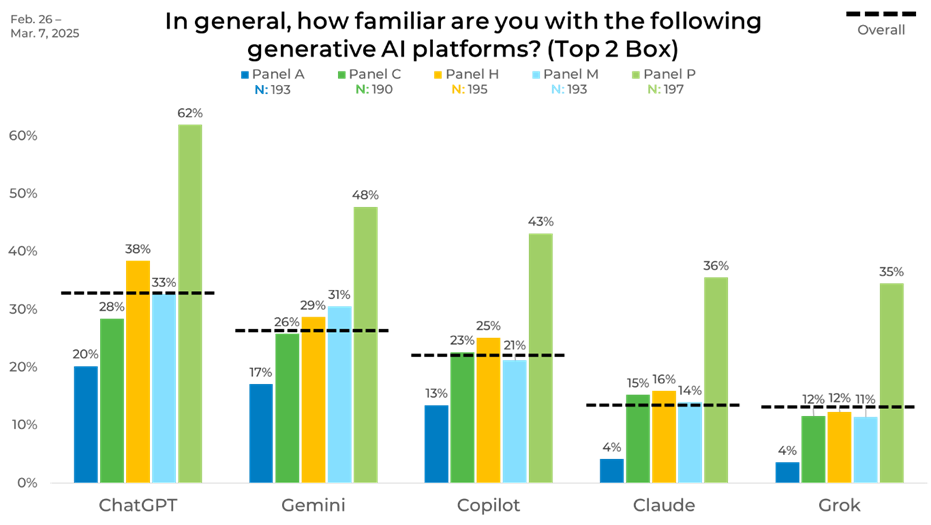
To ensure that panel differences don’t impact data on your next study, click the button below to learn about Strategic Sample Blending.




